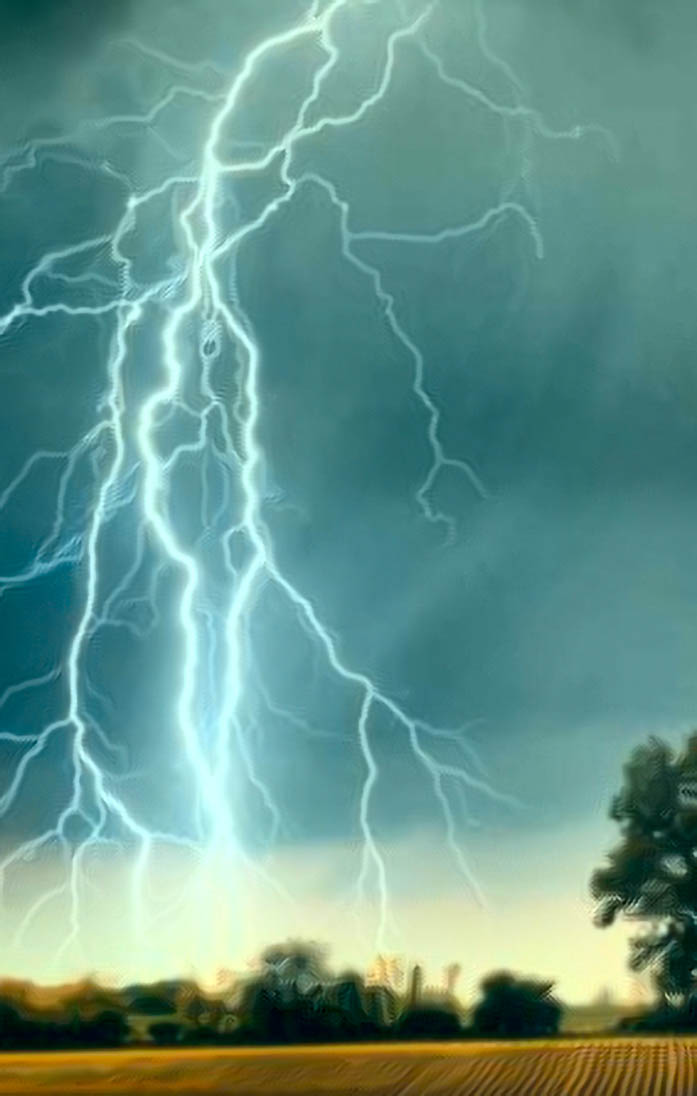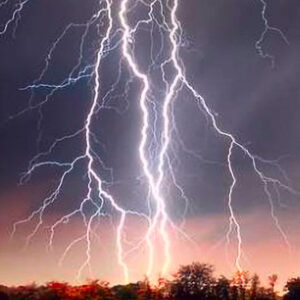
8. Storming
If either of our German Shorthaired Pointers, Ziggy or Tesla, had chosen to pursue their breed’s preferred profession, i.e. accompanying people with guns on bird hunts, it is likely that neither hound would have reached the pinnacle of their potential. For that fact is, incredible as they both were in most of the required areas of hunting: keen site, astounding sense of smell, advanced understanding of bird psychology and the fundamentals of flight, neither had much tolerance for loud noises, such as gunshots. And a birddog who wants to hide under your coat at the first sound of engagement, is unlikely to be prized in the field.
The fact is, the same was true for fireworks on the 4th of July (no matter how distant), the annual Fleet Week visit of the Blue Angels flying over San Francisco in tight formation at 100 feet above us, or even thunder.
Which presents us with a delicate problem. I’d love to introduce an exciting part of classical music that, and maybe this is that rare exception, your bestest four-footed friend might not like as much as you or your human prodigy. I’d like to share with you some inclement weather, storms with screaming winds and crashing thunder. So maybe, just once, you can mention to the flea-bearing one that she just might enjoy a few moments out of doors while you sample some of these exciting pieces.
And if he or she should wander back and actually fall in love with all the drama, well, that would be splendid.
Let’s start with Beethoven, who wrote 9 great symphonies, and none but one tried to tell a story. One through 5 and 7 through 9 are all normal Beethoven symphonies, formally structured, full of amazing melodies and variations, beautiful on first hearing yet so complex they will continue to reveal their secrets over decades of listening. And then there’s the 6th, the ‘Pastoral.’ Unlike the other eight with their four movements or sections, the 6th, has five movements, and Beethoven wrote a little description for each one, so you could picture what he was trying to evoke about the real world that delighted him when he made his frequent walks in the Vienna countryside.
The five movements are. “1) Awakening of cheerful feelings on arrival in the countryside.” Sounds cheery, doesn’t it, and it is quite charming. But for these purposes, please skip it. The second section is “Scene by the brook.” More of the same. Beautiful. Skip it. The third brings us a merry gathering of dancing local folk. Bucolic. Pass.
And then comes what we’re looking for: the fourth section, “Thunder, storm.”
I’m not going to walk you through it (no need for both of us to get wet) but I should point out there are some bird sounds that are pretty fetching for someone who might still be on your couch, but still, you need to give warning about what’s ahead. The interesting thing about these bird sounds is that Beethoven is very un-Beethovenistic about them. These bird imitations are quite playful, but they are also one of only a very few times in all of Beethoven that I know of in which he doesn’t develop the bird themes. He doesn’t make variations on them, he doesn’t hand them off from instrument to instrument. He just lets the flute and the others do their thing and then be forgotten.
Suggested performances? This is one of those hard-to-wreck pieces, so take your choice.
(I probably should digress here and explain what I mean by a ‘hard to wreck piece.’ All the major orchestras of the world, and there are many dozens, know all the core pieces of classical music pretty well, and have played them under a number of different conductors. So if once in a while a visiting conductor comes along who may never have conducted a well-known piece before, the orchestra is going to be just fine — even if the conductor needs to take an emergency bathroom break halfway through, the orchestra will continue on without ill effect until he or she returns to the podium. I’ve never heard of this actually happening, but you never know.)

I love George Szell and Cleveland for all the Beethoven symphonies, and the 6th is no exception. But if you want someone who’s really focused on squeezing every drop of drama from the storm, there’s a great performance with John Eliot Gardiner conducting the Orchestre Révolutionairre et Romantique.
Johann Strauss II was known as ‘The Waltz King’ when the waltz was all the rage in Vienna at a time when there were enough young people in Vienna to rage, which was most of the 19th century. Strauss waltzes, in the right hands, are dynamic, showy, turn on a dime and full or ear-catching tunes. Strauss’s Unter Donner und Blitz (Thunder and Lightning) Polka is simply a blast. And if you’re a Chuck Jones fan (Warner Brothers cartoon genius) then you’ll gain some insight into his musical inspirations.
Best recordings: Sir John Barbirolli with the orchestra he created, the Hallé Orchestra, never forget that this is a storm, and the thunder and lightning remains at the forefront no matter how much the music may want to wander into Paris Follies territory (you know, can-can!) Another stunner is the gorgeous playing from the Chicago Symphony under Fritz Reiner, full of fantastic detail (this is a restoration from the original 3-track all-tube recording from the glory days of RCA Victor’s Living Stereo technology) which still sets a high standard.
And if you’re that kind of person, a wee bit wicked, and you would enjoy a truly awful performance to prove to yourself that the performance of any piece is what truly matters, find, on Idagio, Julius Herrmann leading the Original Hoch- and Deutschmeister wind ensemble, which sounds as if it was recorded live and uncorrected via orange juice can and string at 4 in the morning on the last night of Ocktoberfest. The thunder and lightning are so muted that even the most anxious Dachshund will not be alarmed. I am grateful that Strauss II did not live to hear it.
When I was first attempting to live in France I was passionate about curating French ‘expressions idiomatique’ in order to gain insights into the French mind through the strange little expressions that were unique to their language. Among my favorites was, “La mer fait les petits agneaux,” as I recall it being said to me by a friend in our little village overlooking the Mediterranean one windy day. The delightful translation I was offered was, “The sea is making little sheep.”
Now imagine those little lambs have suddenly grown up into mighty, and even angry ewes. Here is the most massive storm piece of all. It’s the length of a modest symphony, just a little over 20 minutes, and it never sets foot on dry land. Claude Debussy’s La Mer was written at the very beginning of the 20th century, and is one of the great attempts to do in music what the Impressionists had been doing for quite awhile in paint — evoking the feeling of a scene by creating in the viewer through every conceivable manipulation of light, color and texture, the emotion of the moment, not just offering a cool witness to a long-forgotten picnic sitting in a gilded frame. Debussy, in La Mer, puts us at sea, not in a boat as far as I can tell, but just slightly above the water, not drowning, but not dry either.
This is one of the most recorded works in classical music, so discovering the best performance might be something you need to do for yourself over the coming year (two La Mers a week for a year should do it, or you can spread it out). I’d start with the gold standard, George Szell and the Cleveland Orchestra, and then hear Charles Dutoit with the Orchestre symphonique de Montréal.
In my view, there is a flaw in the work, and I didn’t realize exactly what it was until I began listening to dozens of versions for this article. See if you don’t agree with me. The third of the three movements, which is a dialogue between the wind and the sea, is positively thrilling throughout. That is, until the end. The music builds to an exciting climax between the great forces of nature, and then it arrives at a final chord as if one side has actually triumphed over the other (which, the wind??, the sea??). French horns are trilling on top of all the excitement, and then nothing. And I mean nothing at all. It’s over. What? Somebody drained the lake? The ocean went away? The earth really is flat and we just fell off the edge? If I were to rewrite that ending, I’d just grab some of the exciting ocean writing from earlier, and let it go on and on, and slowly fade away, conveying the sense of infinity.
Oh, Claude. I can see that we might be leaving the ocean, but it would never leave us.
